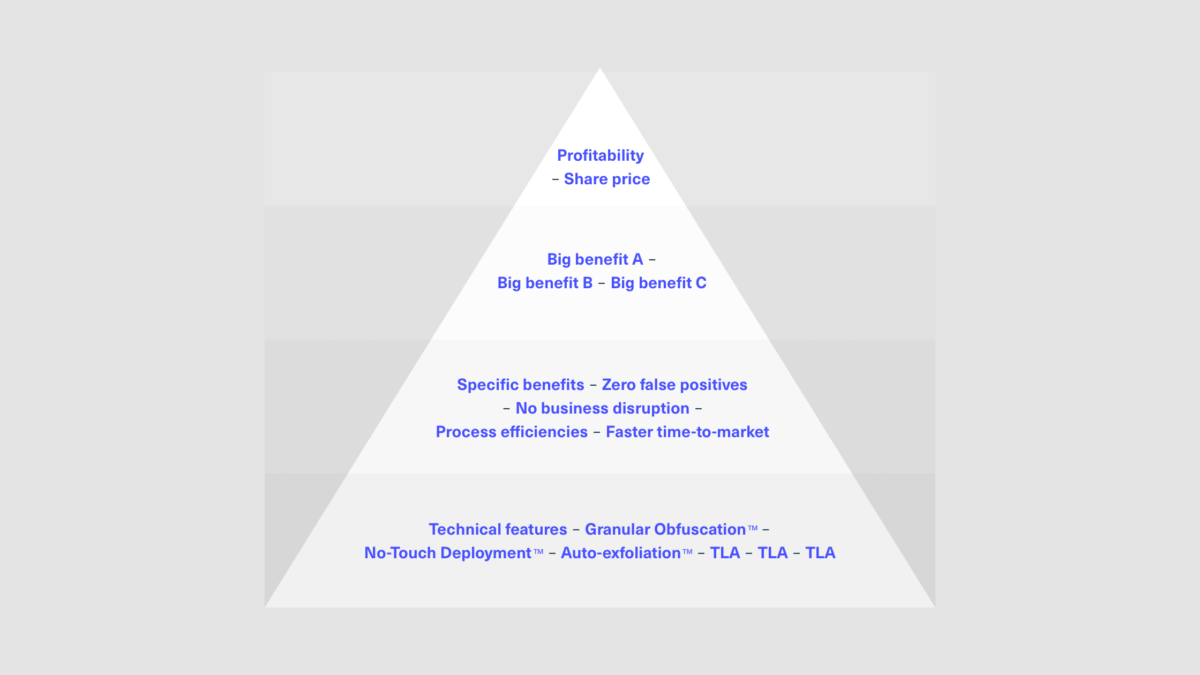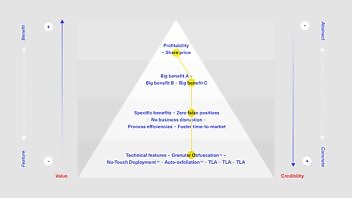How to connect your technology features to your high-order benefits and vice versa.
When companies bring Velocity in to sort out their messages, we always ask what’s wrong with the way they’re currently telling their story.
A surprising number say something like, “We’re okay talking about our technology and not so bad talking about the topline benefits, but there seems to be a gap somewhere in between.”
Even if they don’t say that, they ought to – because almost every technology company seems to get stuck trying to find the right balance between tech-talk, feature-speak and business benefits.
If all you do is talk big benefits, there’s no credibility. If you spend all your time on features, it’s a big, “So what?’.
To explore the issue, we like to whip out our Hierarchy of Benefits slide, which starts out looking something like this (with the client’s real features and benefits inserted):

As you can see, the technical features are at the bottom — they may be important but they’re not benefits in themselves.
The next layer up holds what a lot of techies might think of as benefits. Things like ‘process efficiencies’ or ‘best detection rates in the industry’. To people steeped in the market, just saying these things feels like benefit talk – but to others, they’re means rather than ends.
Next step up the pyramid are the Big Benefits – the core of the company’s positioning and the heart of its messages. ‘Drives down the cost of bunion removal’; ‘Eliminates the need for expensive audits’; ‘Lets you do three times more with the same people’.
These Big Benefits should be aired a lot. And sometimes, they’re as high as the company should ever go. Because the very highest level is either beyond the target audience’s domain or because it’s heavily suggested by the layer below.
At the very top of the Hierarchy are the real reasons companies do things: to increase profit, drive up the share price or both. Again, this level may be too high to use overtly in marketing, but it’s good to remember what the end-end benefit is, to keep everything else in perspective.
Now comes the interesting part.
We like to add two scales down the right and left sides of the Hierarchy, so it looks like this:

On the left hand side, we have “Value”, showing that the highest value things appear higher on the pyramid and the lowest value at the bottom.
On the right hand side, we have “Credibility” – but this time the arrow is reversed. The highest-value benefits are also the least credible and the most credible things are, unfortunately, the ones your prospects care least about.
The inversion of these two scales and their attributes – Value vs Credibility – strikes at the heart of the communications problem in B2B tech marketing:
The claims that people care about, they don’t believe.
And the claims they believe, they don’t care about.
Think about that for a while. Credibility and value are inversely related.
Building bridges
When people first see their Hierarchy of Benefits, there’s a lot of talk about ‘where we should be aiming’. It’s as if the challenge were to find the right level and put all marketing efforts there.
But that’s not the point. The point is to connect the lowest and highest levels in meaningful ways.
To create vertical chains, bridges if you like, that link each feature to the benefit levels above; and each benefit to the lower-order benefits and features below. Kind of like this:

These bridges do two very important things:
They indicate the value delivered by your technical features.
They add credibility to your benefit claims.
So instead of saying ‘We’re the only widget with Auto-exfoliation™” (who cares?), you find yourself saying, “Our Auto-Exfoliation™ technology means excess bytes are removed on-the-fly – saving administrators time and dramatically reducing the cost of sale.”
And instead of saying, “Our Widget makes you more profitable!” (says who?), you add credibility with something like, “Our Widget uses patented auto-exfoliation to remove the tasks that take 60% of every administrator’s day – and slow time-to-market by weeks. The result is more productive IT people and products that generate revenue instead of costs.”
Where you need bridges
If our job as marketers is to help buyers self-educate so they make better, more confident decisions (to buy our stuff), then bridge-building is the heart of B2B marketing. Especially for tech products, where massive value can hide behind arcane features.
The idea is not to build bridges in our internal Message Stacks or even to build them in our marketing content. The idea is to build bridges in the minds of our prospects.
So they learn the real value of your most important technical features—and they start to believe your benefit claims (because you’ve supported them, tying them to specific things you’ve designed into the product).
Of course, there are other ways to build credibility in B2B marketing (reviews analyst reports, customer quotes, data…). But if you don’t have a logical reason to believe, your prospects will struggle to make the leap.
That’s one reason we tend to dig deep into the techie weeds with our clients—not so that we can shove the techie features to the front of our stories, but so that we can give prospects solid reasons to believe our more important claims.
That’s why you need bridges wherever you communicate product messages to the market. On almost every web page, in every blog post, ebook, product demo, sales deck, webinar and video.
If you spot a tiny tech feature floating out on its own – link it up to a benefit. And if you find yourself making big bold benefit claims without support, link them up to credibility-builders from lower down the hierarchy.
Go off and build bridges
This is about more than the well-known (if little-practiced) advice to tie features to benefits. It’s making the marketing team aware of the inverse relationship between credibility and perceived value and actively working to solve for that.
It doesn’t mean giving yourself permission to drench your prospects in a tech-feature firehose. It means selecting the features that really do hide value, and making that case. In parallel, it means identifying the benefits that prospect value most and making sure you’re supporting them really, really well.

Enjoyed this article?
Take part in the discussion








Comments
Chris Turner Bright Blue Kite March 21st, 2019
Hi Doug, really interesting and useful analysis. Have you come across the idea of Attribute Value mapping? It is a very similar process to the one you’ve described but it also enables organisations to see attributes (or features) which don’t add any value. Finding these then raises the question of whether they’re actually necessary and can potentially be discarded.
Doug Kessler March 22nd, 2019
Thanks, Chris. I hadn’t heard of Attribute Value Mapping but just looked it up and it’s fascinating.
Must dig down more into it.
Thanks for the reference!
Ross Chapman PortSwigger February 17th, 2020
Hi Doug, I’ve been using this blog post for the last 11 months – thank you. But, as I go to use it again, I find I want to see examples of B2B websites that ‘bridge’ well. What do you recommend?
Doug Kessler February 20th, 2020
Hi Ross. Thanks for that. Drift does a good job bridging features to higher order things.
Also Hubspot. And Typeform.